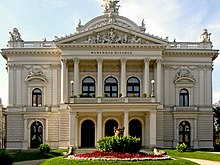Josef Nebehosteny
Josef Nebehosteny (born August 8, 1852 in Vienna , † January 12, 1921 in Brno ) was an Austrian architect . He was involved in the construction of the Brno City Theater (now the Mahen Theater ) and, as an independent architect, was responsible for the construction of several important buildings in Brno.
Life
Nebehosteny studied from 1870 to 1872 at the Academy of Fine Arts in Vienna . He completed his internship with the architect Paul Wasserburger in Vienna, with the Südbahn and in the Atelier F. Fellner the Elder. J. & H. Helmer . In 1881 he came to Brno as the leading architect in the aforementioned studio for the construction of the German City Theater .
Since 1883 he worked as a freelance architect in Brno and lived in Křenová 68. He built a number of public buildings such as the Palace of Justice (today Brno District Court, Rooseveltova 16/648), as well as several villas and apartment buildings.
A selection:
- 1898–1900 today's Brno Financial Administration (náměstí Svobody 4/98)
- 1900 the building of the funeral ceremony hall of the Brno Jewish Cemetery
- 1902–1905 the renovation of today's Brno Central Station ( Brno hlavní nádraží )
- 1906–1910 the German University of Applied Sciences Brno (today Faculty of Social Sciences at Masaryk University, Joštova 10/218)
- 1906 the so-called "Small Villa" Löw-Beer in Svitávka
In 1909 Nebehosteny was appointed President of the Association of Builders and in 1913 President of the Association of Architects of Moravia and Silesia. He also accompanied other offices, e.g. B. he was the first vice-president of the Moravian Trade Association.
Web links
- Via Nebehosteny on the official BRUNA website
- Personal data on the website of the Brno City Online Encyclopedia (Czech)
- Mention of the funeral ceremony hall with photo on the website of the Jewish Community Center Brno
- Villa Löw-Beer on the website of Villa Tugendhat (English)
- Description of the building of the German Technical University Brno (PDF; 9.7 MB) on the website of the Faculty of Social Sciences of the University of Brno (Czech)
- Description of the Mahen Theater on the pages of the theater database (with photos, English)
- Description of financial management on the website of a restoration company (with photos, Czech)
Individual evidence
- ↑ Handbook of Art Care in Austria. Wilhelm von Weckbecker, Kaiserl. Royal Schulbücher-Verlag, Vienna, 1902, p. 615.
| personal data | |
|---|---|
| SURNAME | Nebehosteny, Josef |
| BRIEF DESCRIPTION | Austrian architect |
| DATE OF BIRTH | August 8, 1852 |
| PLACE OF BIRTH | Vienna |
| DATE OF DEATH | January 12, 1921 |
| Place of death | Brno |



